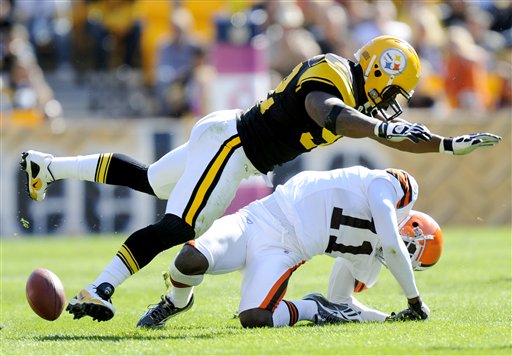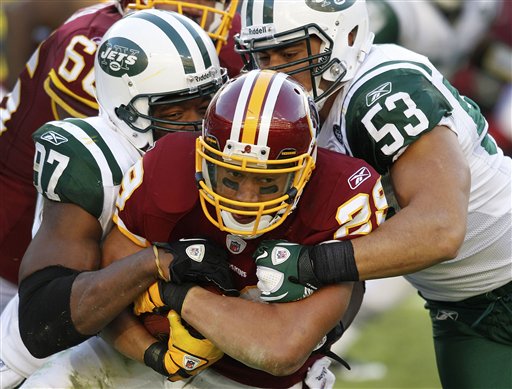

Pittsburgh Steelers linebacker James Harrison (92) hits Cleveland Browns wide receiver Mohamed Massaquoi (11) during the second quarter of a an NFL football game in Pittsburgh. Harrison was fined $75,000 on Tuesday, Oct. 19, 2010, for his hit against Massaquoi. (AP Photo/Don Wright, File)
A few years ago, I saw a pretty cool movie called A History of Violence.
Its narrative is actually quite gripping. The protagonist, whom we think is a small-town bumpkin, is actually a reformed hitman. He’s assumed a new identity, married, started a family, and owns and operates a diner in a sleepy town. Trouble, however, finds him when some shady characters from his past decide to pay him a visit, the objective of which is not to say hi, as you may have guessed.
Of particular note for the sake of this column, there’s a recurring theme throughout the movie that deals with the nature of how we, as an audience, digest and process violence as we encounter it in our various brands of entertainment.
The filmmakers achieve this ethical proposition in an ingeniously simple way: They include a handful of gruesome but realistic camera shots. They don’t cut away. They don’t gloss over. For all the gratification of our hero’s conquests in the face of evil as he clings to his newly virtuous life, it always seems to be mitigated by some horrifically grotesque shot of a guy’s blown-off face. When a thug has a scalding-hot coffee pot smashed and raked across his mug, we see his skin boil and tear. There’s no reprieve from the realistic portrayal of the violence for which we lust. There’s no freebies, as it were.
Lately, it seems, the NFL and its fans have been confronted with this very dilemma. Of course, I’m referring specifically to the cluster of vicious hits on Sunday, which have caused a minor uproar over safety in the league. In a matter of about an hour, in a handful of different games, a few knockout blows were delivered.
Todd Heap suffered a concussion at the crown of Brandon Meriweather’s poorly aligned spear shot. The slight DeSean Jackson was flattened by Dunta Robinson in a sickening full-speed collision, concussing both players. Josh Cribbs and Mohamed Massaquoi were both KO’d on separate helmet-to-helmet hits by the notoriously hard-hitting James Harrison.
And like the gory encounters in A History of Violence, we were left to sit uncomfortably and observe the carnage on Sunday. We weren’t afforded the tidily palatable luxury of watching players spring up without incident, as they miraculously manage to do so many times throughout the course of a season. Instead, we were left to wonder whether these men were seriously injured, whether they’d walk again.
I don’t think I’m alone when I say that I’ve seen more than a few crushing hits on a crossing route or a crackback and wondered whether someone had sustained mortal injuries. Sure, that question doesn’t usually arise very often, nor does it remain unanswered especially long. Maybe I’m just more squeamish than your average football fan, but I swear I held my breath when I saw the shot Kurt Warner took in last year’s playoffs against the Saints. It effectively ended his career.
Look, football is a brutal game. This is not news. For the rough-and-tumble types among us, this is part of what they like about the sport, and for those who prefer strategy and philosophy and analysis, the metric revolution has made the game palatable in ways that it wasn’t when, say, Jack Lambert was clotheslining ballcarriers and the down-field pass was considered a sign of weakness.
But football with consequences is still something of a foreign concept, regardless of all the haunting stories of guys mangling their bodies beyond use or dying broke. Maybe that’s because of how we prefer to digest our entertainment, or maybe there is something more insidious going on subtextually.
Whatever the reason, the pervasive illusion of violence and invincibility is a fallacy that does no one any good. Players pay this toll either now or later, and what’s worse, we barely scratch the surface of the devastating long-term effects (on them or us). That, in a way, is part of what makes football distinctly American. Not to derail this into a sociopolitical rant, but I can’t shake the feeling that there’s more than a fair measure of willful ignorance and complacency with respect to how we compartmentalize the game’s unseemly underbelly.
Those corny cliches that we’ve come to realize are essentially worthless in baseball (e.g. toughness and intimidation and strength) are virtues — badges of honor, really — on the gridiron, and we invoke them to combat intelligent discussion about how to make the game safer because that very well might require us to admit that the old ways of thinking and the longstanding traditions aren’t necessarily right.
“You want to legislate potentially crippling hits out of the game? What are you, a wimp?”
Look, I’m not pulling the moral high ground on anyone here, because we, as a football-loving culture, are all complicit — fans, players, coaches, and leagues. I’m an avid fan of the game, and I’d be lying if I said I wasn’t pleased when Darrelle Revis crushed an unsuspecting Eddie Royal last week, causing a dropped pass and an incompletion. But I also didn’t like it when Royal was laying on the ground after Revis got a running start and launched into him.
What we can and should do is change — the way the game is played, officiated and cheered. To me, it looks like a lot of the worst collisions are just that — collisions and not tackles. Commissioner Mennella’s new rule is this: If a would-be tackler doesn’t attempt to tackle using the correct form, meaning keeping his head up and trying to wrap up with his arms, it’s a 15-yard penalty. That means no more free runs on guys and burying the helmet, shoulder or forearm into someone’s chin. No part of the body nor the body itself can be a weapon or projectile. We all gripe about the lack of poor fundamental tackling, so this is a chance to institutionalize it. If a player can’t tackle properly, he will be penalized until his coaches see fit to remove him so as not to hurt the team. Simple as that.
Now, what of us fans? Well, far be it for me to tell anyone how to enjoy his or her entertainment. But bear in mind, players are vulnerable human beings, albeit gifted athletes. Football is a collision sport, and I’m not arguing that should be changed in a fundamental sense, per se. But next time we see a Stewart Bradley sickeningly stumbling to the ground as the result of an obvious concussion, we might look closely at him and understand the place of our bloodlust in the game’s violent vortex instead of trying to dismiss it as a necessary evil. Let’s stop giving ourselves a freebie.
Dan Mennella is a reporter and editor for MLB.com. Check out his blog, danmennella.com, and follow him on Twitter @danmennella.





